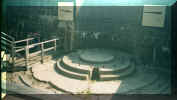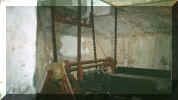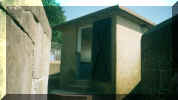Walking Tour of Fort Mott
This is what you will see on a walking tour of Fort Mott.
- Batter Gregg
- Battery Gregg was completed in December 1900 and contained emplacements
for two 5-inch rapid fire guns mounted on barbette pedestal mounts with shields.
After the guns were removed in 1913, an observation station for Battery
Harker's Commander was installed in one of the gun emplacements.
 Battery Harker
Battery Harker- Battery Harker had three 10-inch guns mounted on disappearing carriages.
Each gun emplacement has a powder and shell magazine located beneath the gun
platform. Electric hoists were at each gun emplacement to lift the
ammunition to the large guns.
 Disappearing Gun Carriages
Disappearing Gun Carriages- The main defensive concept at Fort Mott was the installation of
high-caliber weapons on disappearing carriages. the large guns were loaded
and aimed while concealed behind the parapet wall and only raised to fire.
- The Parapet
- This massive concrete wall, as much as 35 feet thick, was designed to
conceal and protect the guns and ammunition magazines from the flat
trajectory fire of enemy warships. this defensive wall was itself protected
by an additional 60 feet of earth in front of the concrete.
- Battery Arnold
- Sharing the parapet with Battery Harker, the three guns of Battery Arnold
were the most powerful armament at Fort Mott. One of these guns could
fire a 1,000 pound projectile eight miles down river. the magazines located
beneath the gun platform could hold 208 rounds of ammunition.
- 1870s Magazine
- Two magazines from the original 1872 construction were used during the
later Endicott defenses.
- Peace Magazine
- Continual problems with moisture in each of the gun emplacement magazines
was an ongoing problem. This storage magazine was built in 1904 to eliminate
the moisture problem. At the same time, a postern gate (tunnel) was built
through the parados and the narrow gage ammunition railroad was
extended from behind the main batteries to the Peace Magazine.
 Battery Edwards
Battery Edwards- Battery Edwards has casemates (enclosed gun emplacements) for 3-inch rapid
fire guns and were constructed form two of the original 1872 magazines.
Battery Edwards was designed to protect the fort from smaller, high-speed
vessels or infantry units landing in front of the fort.
 Battery Krayenbuhl
Battery Krayenbuhl- Battery Krayenbuhl had two 5-inch rapid fire guns mounted in barbette
balanced-pillar mounts. Interior magazines were built below the gun
platforms and electric hoists were used to deliver ammunition. The guns were
designed to protect the channel above and below the fort. After the guns
were removed in 1917, an observation station was installed in one of the gun
emplacements.
- The Switchboard/Plotting room
- During World War I, improvements in fire control of the large caliber
weapons were made at
- Fort Mott. A switchboard was installed to centralize
fire control. This room later became a central plotting room to calculate
target ranges and locations.
 Battery Lane
Battery Lane- Located behind the gun installations, from Battery Harker to the pastern
gate, this area contains the generator room and ammunition railway.
Disappearing gun carriages were invented in Europe and perfected by the United
States army ordnance officers. The design of the carriage utilized a
counterweight system with massive lever arms to support the gun. The protective
wall concealed the guns. After the gun was loaded and aimed, a counterweight,
located in a large pit below the gun, was released to raise the gun to the
firing position.
When the weapon was fired. the upper ends of the arms recoiled backwards and
downwards, which simultaneously raised the counterweight attached to the
opposite ends of the lever arms. This action placed the gun back in position for
reloading, safely behind the wall and away from the enemy's view.
I was so impressed by what I had read about Fort Mott that I had to go see
it. I was even more impressed when I got there and saw the massive size of the
parapet and the size of the gun emplacements. I could only imagine the size of
the guns that used to be there.
 Copyright © 2001-
, Terry Muse
Copyright © 2001-
, Terry Muse
Revised: October 8, 2001
URL: http://www.coastalheritagetrail.tripod.com
Contact: Terry Muse
Coastal Heritage Trail | Delsea Region
 Battery Harker
Battery Harker Disappearing Gun Carriages
Disappearing Gun Carriages Battery Edwards
Battery Edwards Battery Krayenbuhl
Battery Krayenbuhl Battery Lane
Battery Lane Battery Harker
Battery Harker Disappearing Gun Carriages
Disappearing Gun Carriages Battery Edwards
Battery Edwards Battery Krayenbuhl
Battery Krayenbuhl Battery Lane
Battery Lane Copyright © 2001-
, Terry Muse
Copyright © 2001-
, Terry Muse